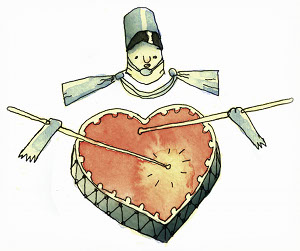Whether you want to pick up a new musical instrument, impress your date with some serious dance moves, or simply clap in time, learning about rhythm will give you the tools you need to get your groove on and make some serious music.

To understand rhythm, you first have to understand the beat. The beat is the glue that holds the orchestra together during a symphony, gives a heartfelt pulse to the the hip hop artist’s rap, and keeps the marching band in perfect unison with a pulsing right-left-right-left.
Hold your hand to your chest and feel the steady rhythm of your heart beat. The constant pulse gives life-giving oxygen to your body in the same way that the beat keeps the music exciting and alive.
Count how many times your heart beats per minute. The number of times your heart beats each minute is called the tempo. Tempo refers to the overall speed of music. For example, if your heart beats seventy times per minute, then the tempo of your heart has a relatively slow musical tempo of seventy bpm (beats per minute). During a workout, your heart may beat 140 times per minute, a very quick tempo.
In sheet music, songwriters and composers use terms like moderato and allegro to describe moderate and fast tempos, respectively. If you are reading music for the first time, you may encounter other terms like adagio or vivace.
Here is a quick list of common tempo markings and approximate beats per minute (bpm):
| Adagio (60 bpm) | |
| Moderato (100 bpm) | |
| Allegro (130 bpm) | |
| Vivace (150 bpm) |
You can practice picking out the beat and tempo by listening to your favorite tunes on your iPod or internet radio station. For example, Beyonce’s Single Ladies (Put a Ring On It) has a moderate tempo while Bing Crosby’s White Christmas has a slower tempo. For a quicker pulse, you can listen to Irish reels from Riverdance or even something like the main title from The Simpsons. As you listen to the music, close your eyes and allow your foot to naturally tap out the beat the same way that you tapped out your own heartbeat. Once you have mastered foot tapping, you can easily add dance moves or hand clapping to the music.
If you are learning a new instrument, you can buy a metronome to help you keep a steady beat. A metronome is a device which keeps a constant click to help a musician keep in rhythm. There are a variety of virtual metronomes available on the internet, like the free Metronome Online.
Now that you understand what beat and tempo mean, you can experience the beat in your everyday life. Enjoy the brisk, quick tempo of a John Philip Sousa march at the next Fourth of July picnic, clap in time to your favorite tune, dance away at the next party, or enjoy playing new music on your guitar. Let the pulse guide you!
Have a question? Got a great tip to share on recognising tempos? Add a comment, or come post in the Rhythm section of the forums!







Wow!! I fully understand what exactly beat and tempo is.. heart beat is directly link to tempo. It's immense power of listening once you reach on the feel of music by closing your eyes you naturally know the sounds and beat the same way that you tapped out your own heartbeat.